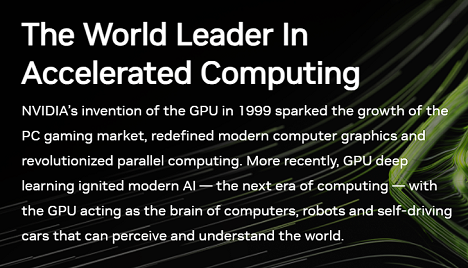
Billions have been invested in the recent new trends of artificial intelligence, cloud computing, electric vehicles, and autonomous vehicles.
The world’s tech giants, including Apple (AAPL), Amazon (AMZN), and Google (GOOG), and others have been pouring billions into artificial intelligence.
MegaTrends: Its Impact on Robotics AI and the Future
Nvidia one company that is driving these megatrends with triple digit percentage returns in the last ten years.
Nvidia (NVDA) specializes in high-performance computer chips known as graphics processing units (GPUs). Initially, GPUs were primarily employed to create lifelike graphics in video games. However, it turns out that GPUs are also exceptionally well-suited for “training” machines to emulate human thinking or what we now call artificial intelligence (AI).
AI is the driving force behind the autonomous vehicle industry.
At the heart of autonomous vehicle lies a central brain that has been trained to identify stop signs, pedestrian crossings, red lights, and other elements encountered by human drivers.
Nvidia’s latest chips boast a processing speed exponentially faster than traditional computer chips. They can handle hundreds of trillion data points per second, reducing AI learning times from days to hours.
This is precisely why over thousands of companies, including industry giants like Amazon, Google, and Microsoft, utilize Nvidia’s hardware to train their AI programs.
Nvidia’s Huge Earnings Surprise Spreads Across Tech
In the last quarter alone, Nvidia’s revenue from AI chip and hardware sales surged by an impressive 80% plus. Over the past two years, AI-related sales have accounted for more than 70% plus of Nvidia’s revenue growth, now constituting 20% plus of its total revenue.
This year, Nvidia anticipates earning approximately $600 million from its automotive business.
As mentioned earlier, Nvidia provides chips for “training” the brains of self-driving vehicles, as well as hardware for processing data from the numerous cameras and sensors on these vehicles.
For instance, Nvidia’s self-driving supercomputer, named Pegasus, can handle staggering hundreds of trillions of operations per second. Moreover, it does so while consuming only one-third of the electricity and at just one-fifth of the cost compared to its closest competitor.
Nvidia’s Positive Effect On Other Companies
Currently, hundreds of companies engaged in self-driving car development rely on Nvidia’s products. Auto sales currently account for just single digit percentages of Nvidia’s total revenue, but the forecast is for a substantial surge in the coming years as true self-driving vehicles hit the market.
Approximately $100 billion has been invested in self-driving car development currently. With industry giants like Google and Apple injecting billions into autonomous vehicle projects, look for this figure to skyrocket to $1 trillion plus within the next few years.
Thanks to its superior technology, Nvidia is poised to capture a significant portion of this growth. While Nvidia is often classified as a high-flying tech company, it bears no resemblance to many of the profitless tech darlings out there. Unlike numerous high-flying tech stocks fueled by stories and hype, Nvidia is exceptionally profitable.
Nvidia Fundamental Metrics
It boasts an impressive net profit margin of 30% plus. In other words, for every dollar in sales one-third translates into pure profit. This profit margin surpasses that of Google’s 20% plus and even Microsoft of nearly 30% profit margins. Nvidia’s robust margins enable it to consistently reinvest more of its revenue into Research & Development (R&D) each year, a significant factor contributing to its superiority over competitors. Moreover, Nvidia maintains a strong financial position, with a record $8 billion in cash on hand, enough to cover its total debt four times over.
Nvidia’s current price-to-earnings P / E ratio of 39.57 and PEG Ratio 2.93 continuing growth potential which could be considered as overvaluation. Nvidia’s earnings are growing at five plus times the rate of the S&P 500, yet its P / E ratio is not even twice that of the S&P’s.
Nvidia Long-Term
Nvidia is at the forefront of the new electric vehicles market, the growing self-driving revolution, artificial intelligence, cloud computing industries, and much more.
Buying, holding, and buying more shares on its dips in price over time can potentially provide exponential returns on investment over the coming years.

